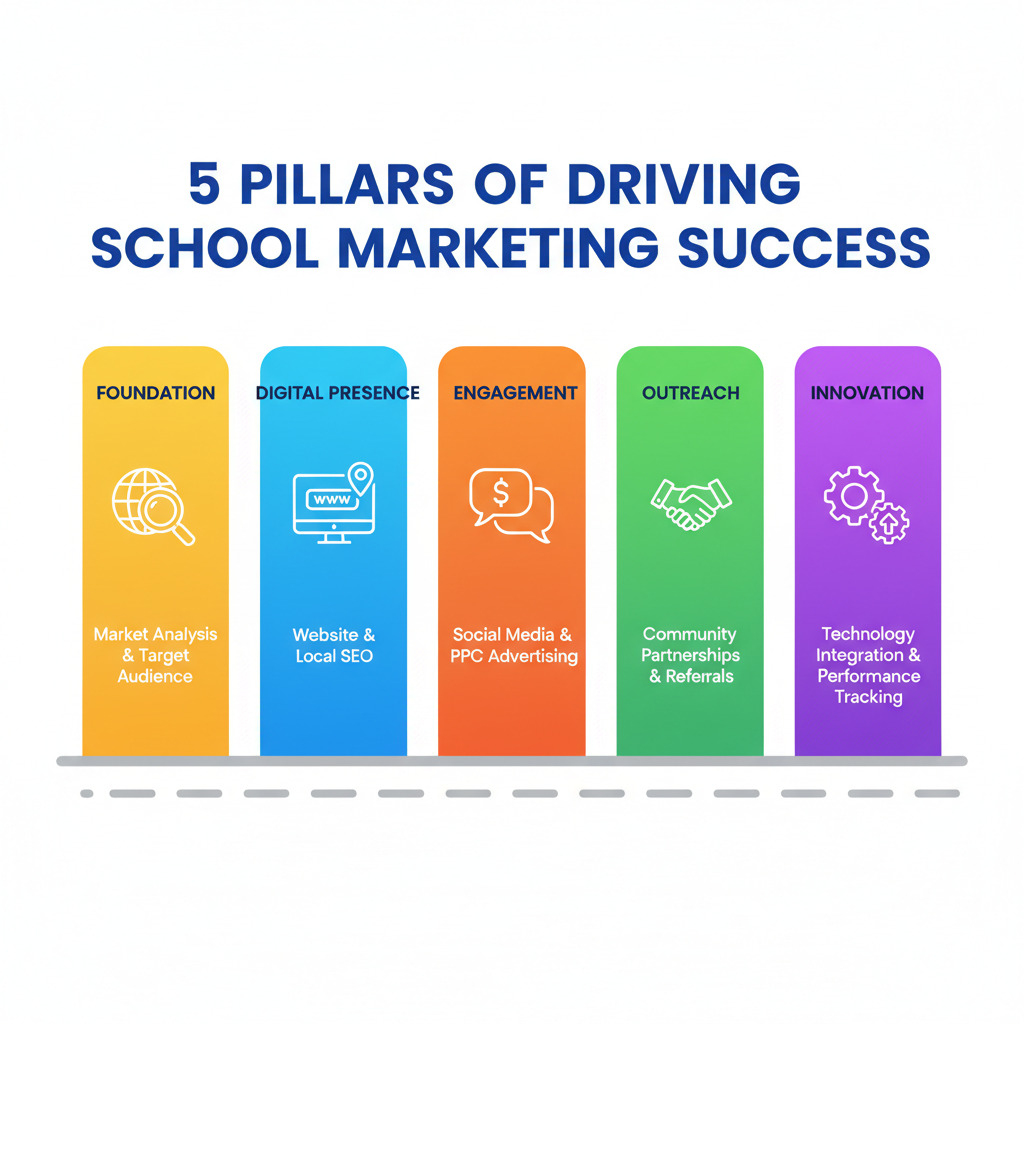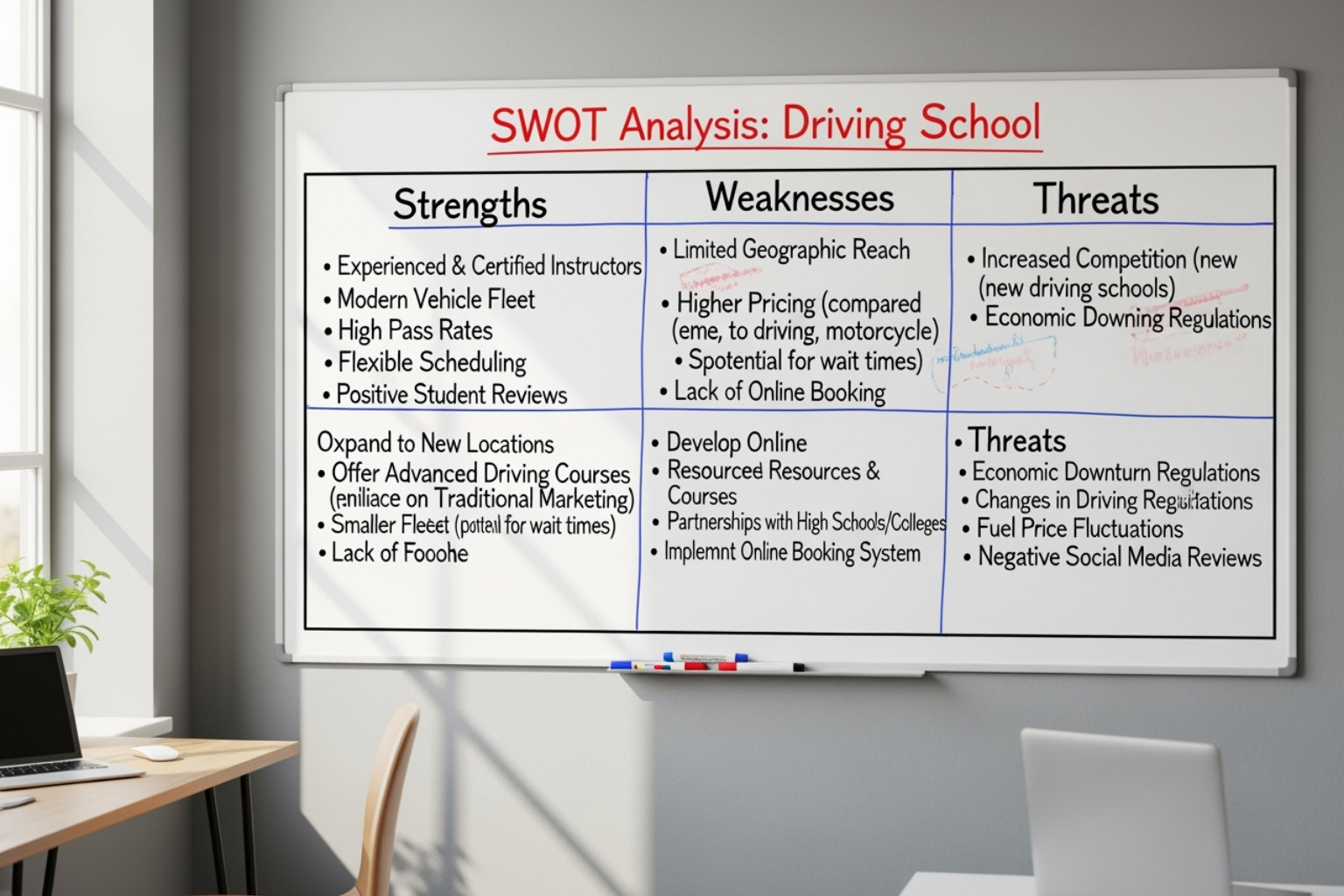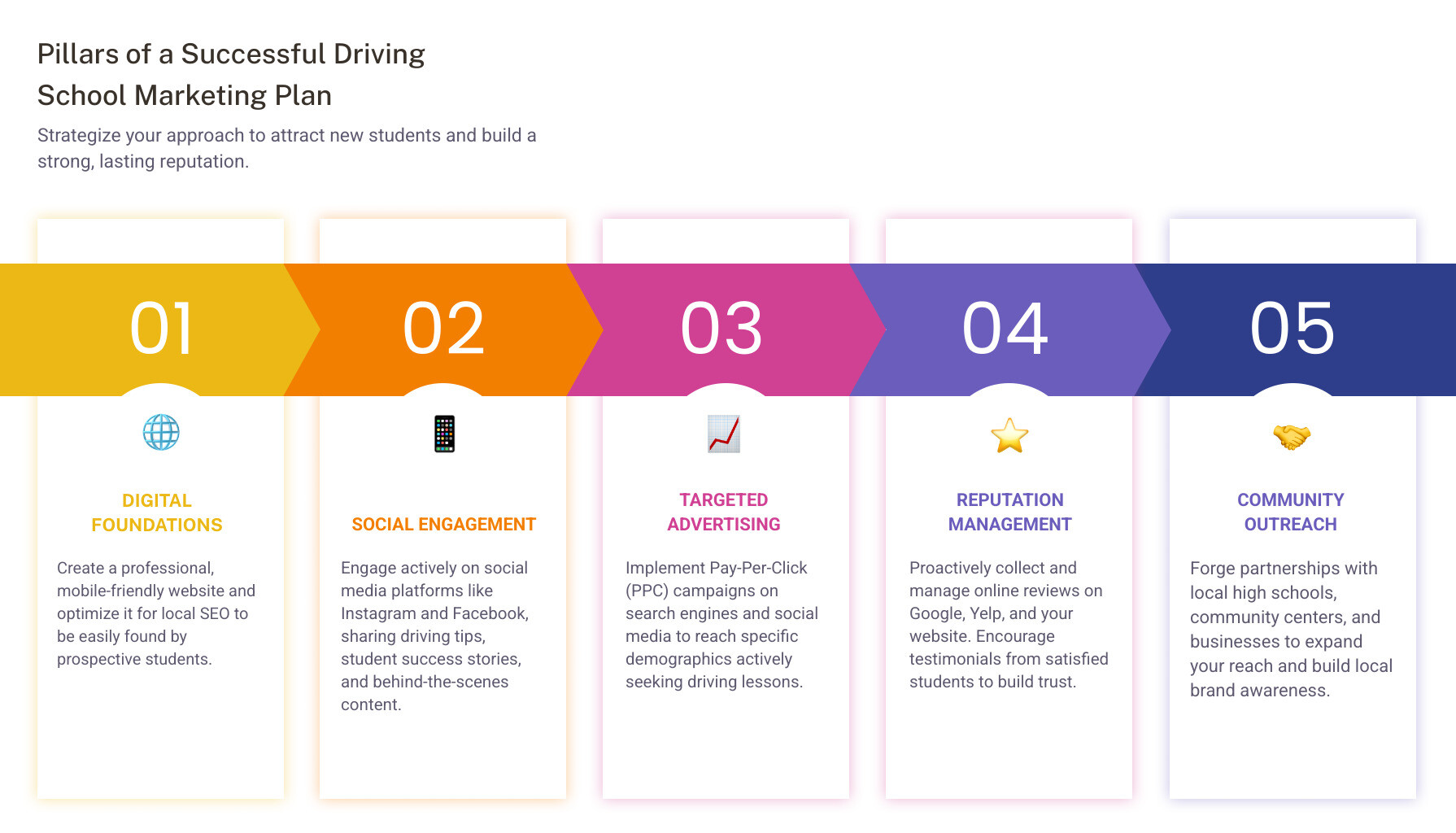Why Your Driving School Needs a Strategic Marketing Plan

A driving school marketing plan is your roadmap to consistent student enrollment. It is a strategic approach to customer acquisition that keeps new learners coming in steadily. Without one, even excellent schools face uneven lead flow in a competitive market.
Key Elements of an Effective Driving School Marketing Plan:
- Foundation: Market research, target audience definition, and unique selling proposition
- Digital Presence: Professional website, local SEO, and Google Business Profile optimization
- Paid Advertising: Google Ads and social media campaigns targeting high-intent prospects
- Community Engagement: Partnerships with schools, referral programs, and local networking
- Performance Tracking: ROI measurement, lead tracking, and conversion optimization
The driving school industry generates over $2 billion annually in the U.S., but success is not automatic. Learning to drive is a major milestone, so demand is steady. Still, schools that neglect marketing struggle. As one expert noted, “Marketing is not just part of the business; it is the business.”
Successful driving schools use a comprehensive approach that builds trust and demonstrates expertise to attract qualified students. Whether you are targeting teens, adults, or commercial drivers, your marketing strategy should align with your business goals and budget. A well-executed plan blends traditional relationship-building with modern digital tactics to drive sustainable growth.

Laying the Foundation: Key Components of Your Driving School Marketing Plan
Before launching any campaigns, you need a solid foundation. Just as you would not teach highway merging before steering basics, your marketing needs a clear structure. Start with understanding your market landscape. The U.S. driving school industry is a $2 billion market, so opportunity comes with strong competition.
Success requires thorough market analysis and strategic planning. Identify your ideal students, define what makes your school unique, and set clear business goals.

Define Your Ideal Student
“Anyone who wants to drive” is not an effective target audience. The more precisely you define your ideal student, the better your marketing will perform. Consider these segments:
- Teenagers (16-18): This is a primary market, but remember you are marketing to their parents. Your message should address concerns about safety, convenience, and value.
- Adult Learners: This growing segment includes new drivers, those needing a refresher, or immigrants adapting to local laws. They value patient instruction and flexible scheduling.
- Niche Groups: Do not overlook new residents needing state-specific instruction, court-ordered students for defensive driving, or commercial drivers seeking CDL training. Each group requires a custom message.
Understanding these differences helps you craft targeted campaigns that convert. Consider implementing Local Online Marketing strategies to reach these specific groups.
Develop a Unique Selling Proposition (USP)
In a crowded market, you cannot be “just another driving school.” Your USP is what makes students choose you. What do you do better than anyone else?
Perhaps you offer specialized courses like defensive driving or winter training. Maybe your instructors are trained to work with anxious drivers—a meaningful differentiator. A high pass rate provides powerful proof of quality. Other USPs could be a modern vehicle fleet with advanced safety features, flexible online booking, or advanced driving simulators.
A SWOT analysis can help pinpoint your advantages. To dig deeper, you can learn how to perform a SWOT analysis for your business.
Integrating Your Driving School Marketing Plan with Your Business Goals
Your marketing plan is the engine for your business growth. Every marketing dollar should connect to your revenue targets. If your goal is to increase enrollment by 20%, your plan should specify the campaigns required to generate those leads. This means setting SMART (Specific, Measurable, Attainable, Relevant, and Time-bound) goals.
Your marketing should support objectives like increased revenue, improved brand awareness, and better profitability. To measure success, track Key Performance Indicators (KPIs) like:
- Cost Per Lead (CPL): How much you spend to attract a potential student.
- Conversion Rate: The percentage of leads who become paying customers.
- Student Lifetime Value (LTV): The total revenue a student generates.
These metrics reveal which activities deliver the best return on investment. For comprehensive planning, consider developing a complete guide on How to Write a Driving School Business Plan that aligns all aspects of your operation.
Building Your Digital Fortress: Online Strategies to Attract Students
Your online presence is the foundation of a modern driving school marketing plan. Think of your website as your digital storefront, working 24/7 to showcase your expertise and convert visitors into students.

Create a High-Performance Website
Your website is often your first impression. A professional site builds confidence, especially for parents entrusting you with their teen’s safety. Key features include:
- Mobile-First Design: Essential, as most parents research on their smartphones.
- Fast Loading Speeds: A slow site sends visitors to competitors. If you are having issues, understand why your website is loading slowly to fix them.
- Clear Navigation: Guide visitors quickly to pricing, instructor bios, scheduling, and contact info.
- High-Quality Visuals: Use images and videos to showcase your modern fleet and friendly, certified instructors.
- Compelling Copy: Speak directly to your visitors’ concerns, whether they are a worried parent or an anxious adult learner.
Regular website maintenance keeps your digital storefront in peak condition.
Dominate Local Search with SEO
When someone searches “driving lessons near me,” you need to appear. Local Search Engine Optimization (SEO) ensures your school is visible when it matters most.
- Google Business Profile Optimization: This free tool is your digital billboard. Optimized profiles are 70% more likely to attract location visits. Keep your hours, photos, and reviews updated.
- Local Keywords: Weave location-specific terms (e.g., “driving lessons in Boston”) naturally into your website content, titles, and descriptions.
- On-Page SEO: Create dedicated service pages for each type of instruction (e.g., teen courses, adult lessons) to match specific search intent.
- Link Building: Earn links from local high schools, community groups, and businesses to boost credibility and search rankings.
Our SEO Service (Gold Plan) helps driving schools climb local search results, ensuring qualified prospects find you first.
Create Compelling Content
Content marketing establishes your school as a trusted educational resource. By sharing valuable information, you build relationships with potential students before they enroll.
- Blog Posts: Write practical tips like “Mastering Parallel Parking” to attract organic traffic and showcase expertise.
- Video Tutorials: Create short videos demonstrating proper mirror adjustment or explaining right-of-way rules. These are highly shareable and effective.
- Student Success Stories: Share authentic testimonials from students who passed their tests. This social proof helps convert hesitant prospects.
- Infographics: Highlight road safety statistics with shareable visuals that reinforce the need for professional instruction.
Consistently updating your blog with fresh content keeps your audience engaged and signals authority to search engines.
Driving Engagement: PPC, Social Media, and Reputation Management
With a solid digital foundation, it is time to actively connect with potential students. This phase of your driving school marketing plan focuses on creating engagement through paid advertising, social media, and online reputation management.

Leverage Paid Advertising (PPC)
Paid advertising (PPC) offers a fast lane to your ideal students. While organic strategies build momentum over time, PPC delivers immediate visibility to motivated prospects.
- Google Ads: Capture high-intent searchers who type “driving lessons near me.” These users are ready to decide, and PPC can generate immediate calls and inquiries.
- Facebook & Instagram Ads: Use demographic targeting to reach specific audiences, like parents of 16-year-olds in your service area. Visuals of your modern fleet and success stories work well.
- Retargeting Campaigns: Stay in front of website visitors who did not enroll. Timely reminders can bring them back when they are ready to commit, often with a strong return on investment.
- A/B Testing: Continuously test ad copy and headlines to learn what resonates with your local market and improve performance.
Professional Ad Campaign Management ensures your budget is spent efficiently, targeting the right people at the right time.
Master Social Media Marketing
Social media turns your driving school into a community. It is where you encourage nervous teens, share success stories, and showcase your expertise.
- Choose the Right Platforms: Focus on Facebook to reach parents, Instagram for visual storytelling (your cars, your students’ success), and TikTok to connect with teens through short, engaging driving tips.
- Create a Content Calendar: Plan posts to maintain a consistent, professional presence. Mix educational content with posts that show your school’s personality.
- Engage Authentically: Respond promptly and helpfully to comments and messages to build trust and turn followers into community members.
- Run Contests: Boost engagement with giveaways, such as a free lesson, to generate buzz and highlight community involvement.
Our Social Media Management Plan helps driving schools maintain a consistent presence. We also offer specialized Instagram Marketing for Business strategies.
Harness the Power of Reviews and Testimonials
Online reviews are the modern word-of-mouth. Positive reviews build immediate credibility and address common concerns like instructor patience and safety.
- Social Proof Drives Decisions: 9 out of 10 people read online reviews before choosing a service. For driving schools, this is crucial.
- Ask for Reviews: After a student passes their test, ask them to share their positive experience online. Provide direct links to your Google Business Profile or Facebook page to make it easy.
- Showcase Testimonials: Feature glowing reviews on your website’s homepage, in social media posts, and in your ads to amplify impact.
- Respond to All Reviews: Thank people for positive feedback and address negative reviews with empathy. A thoughtful response to criticism can impress potential customers.
This engagement cycle—great service leading to positive reviews, which attract more students—creates sustainable, organic growth.
Expanding Your Reach: Offline Marketing and Community Engagement
While digital marketing is crucial, connecting with your community face to face adds a layer of authenticity to your driving school marketing plan. Offline marketing builds trust in ways that digital ads alone cannot.

Build Community Connections
Position your driving school as a community partner invested in local road safety. Strategic partnerships can open doors to new student demographics.
- Partner with Schools and Colleges: Offer road safety workshops or provide special student discounts to create a direct pipeline to your primary market.
- Collaborate with Car Dealerships: New car buyers often need lessons. Dealerships can recommend your services, creating a win-win relationship.
- Engage with Insurance Agencies: Agents are motivated to recommend defensive driving courses that can lower their clients’ premiums.
- Connect with Community Centers: Reach diverse groups, including adult learners and new residents, by offering free safety workshops.
Look for cross-promotional opportunities, such as a local coffee shop displaying your brochures in exchange for a mention.
Implement Referral and Word-of-Mouth Programs
Word-of-mouth is powerful, as 88% of people trust recommendations from people they know. A formal referral program can amplify this effect.
- Incentivize Referrals: Offer current students a discount, gift card, or cash bonus for referring a new student. Provide a welcome discount for the new student as well.
- Provide Exceptional Service: The foundation of any referral program is a great student experience. Happy customers are your best advocates.
- Track Referrals: Use a simple form or unique codes to track who referred new students, ensuring your advocates are rewarded.
Use Traditional and Local Advertising
Traditional marketing methods remain effective for local businesses and can reach audiences that digital marketing might miss.
- Branded Vehicles: Car wraps turn your training fleet into mobile billboards, generating impressions throughout your service area.
- Local Radio Ads: Radio reaches a large audience, many of whom are in their cars—the perfect time to think about driving lessons.
- Flyers and Brochures: Place professionally designed materials in community hubs like libraries, coffee shops, and high school guidance offices.
- Sponsor Local Events: Increase brand visibility and show community commitment by sponsoring a high school sports team or local fair.
- Business Cards: This simple, cost-effective tool remains a great way to make a memorable impression.
Integrated offline marketing builds awareness, generates referrals, and earns the trust that converts prospects into students.
Frequently Asked Questions about Driving School Marketing
Here are answers to common questions driving school owners have when developing their driving school marketing plan.
What is the biggest marketing mistake a driving school can make?
The biggest mistake is neglecting marketing entirely. Hoping students will just find you is not a sustainable strategy in a competitive market. This leads to invisibility, stagnant enrollment, and potential business failure. While word of mouth is valuable (88% of people trust recommendations), relying on it alone is not enough for long-term growth. You need a multi-faceted approach that combines digital marketing, community engagement, and strategic partnerships.
How much should a driving school budget for marketing?
A common guideline is 5-10% of your gross revenue for established schools seeking steady growth. New or aggressively expanding schools might need to invest more initially, around 10-20% of revenue, to build brand awareness. The key is not the exact percentage but focusing on Return on Investment (ROI). Start with a comfortable budget, track your results, and scale up the strategies that prove most effective. A 5:1 marketing ROI is solid, while over 10:1 is exceptional.
How can I make my driving school stand out?
To stand out, define and communicate your Unique Selling Proposition (USP). This is what makes you uniquely valuable to students. Your USP could be:
- Specialized training for nervous drivers.
- A guaranteed pass program.
- A modern fleet with the latest safety features or eco-friendly electric vehicles.
- Highly certified instructors with special training.
- An easy-to-use online booking system.
- Innovative technology like VR simulation training.
Your driving school marketing plan should consistently communicate what makes you the best choice, focusing on the change from anxious beginner to confident, safe driver.
Conclusion: Steer Your Business Toward Long-Term Success
We have covered the essential components of a successful driving school marketing plan, from building a solid foundation and digital presence to driving engagement and connecting with your community. This plan is your living roadmap to consistent student enrollment and sustainable growth.
Like driving itself, marketing requires ongoing practice and adaptation. The industry evolves, and so should your approach. Stay flexible and responsive to market changes while sticking to the core strategies that deliver results. Marketing is an ongoing investment, not a one-time expense. Consistent efforts compound over time, building brand recognition and a steady pipeline of qualified students.
At Brain Jar, we specialize in helping vocational schools like yours boost enrollment through targeted digital marketing. We understand the unique challenges of your industry and can help you create a compelling website, dominate local search, and build a strong social media presence.
Your students trust you to guide them toward becoming confident, safe drivers. We are here to guide your business toward its growth goals. Whether you need web development, SEO, social media management, video production, or paid ad campaigns, our team is ready to help you steer the digital landscape.
Ready to shift your driving school’s marketing into high gear? Contact our Digital Marketing Agency today, and let’s build your customized roadmap to success.
